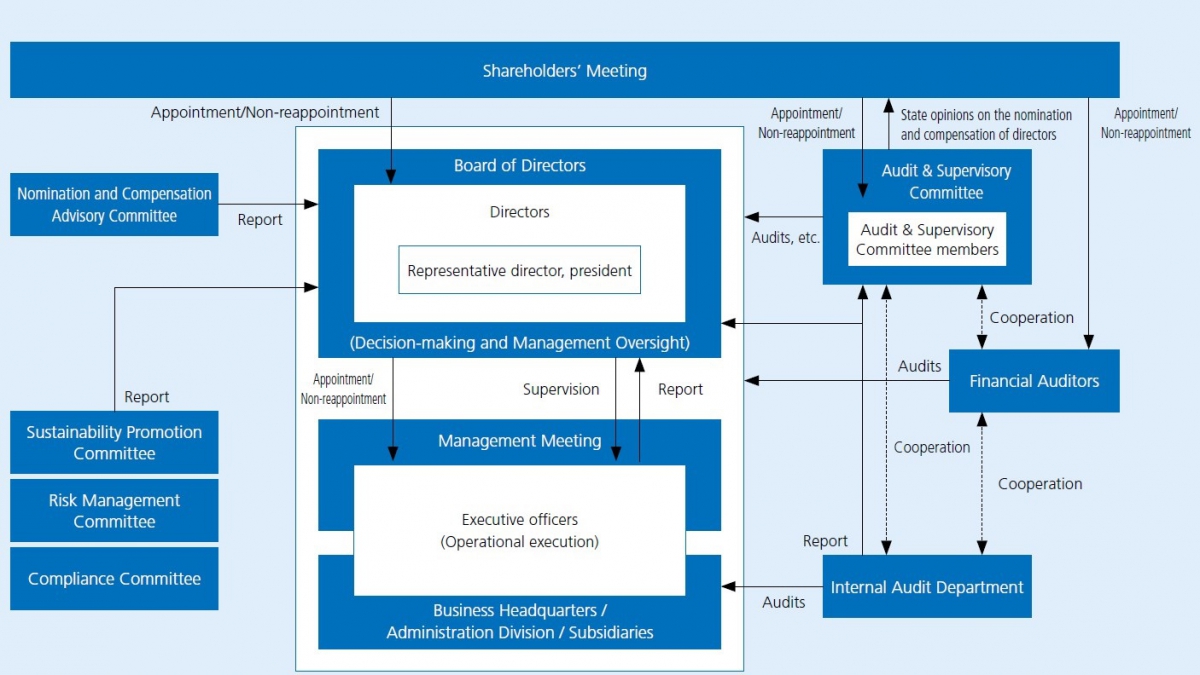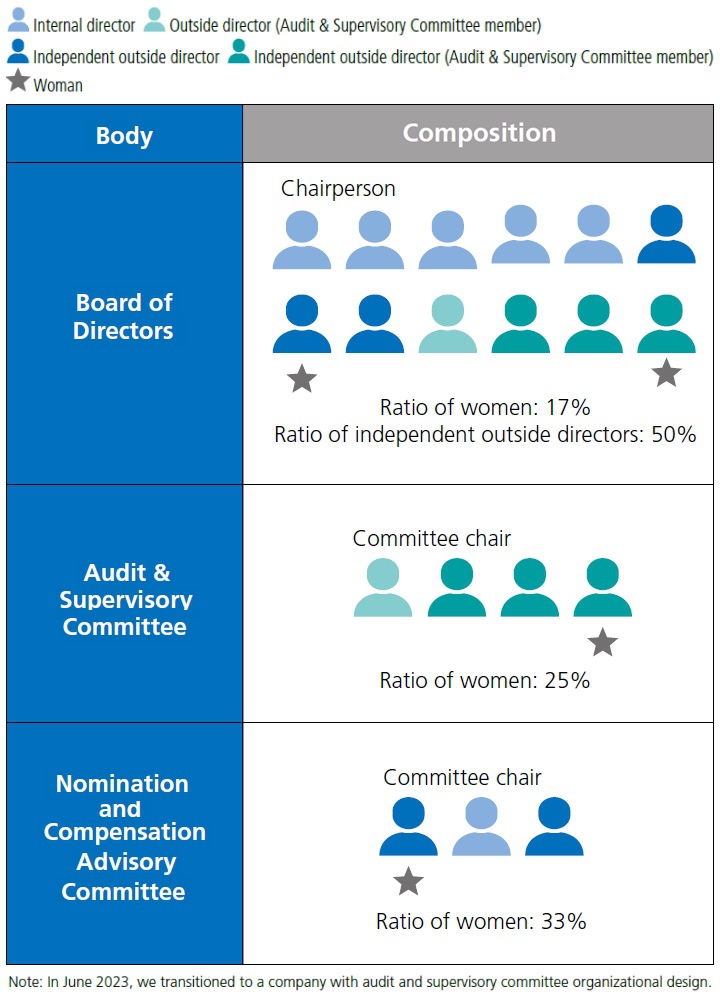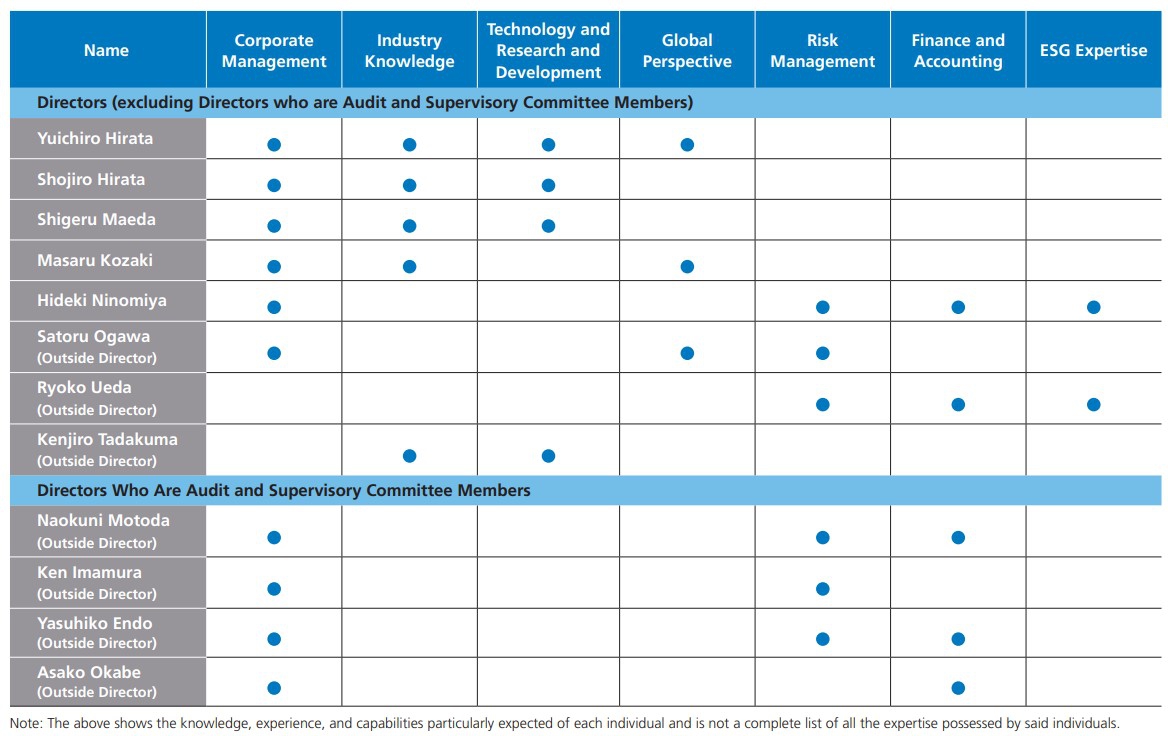Hirata’s Corporate Governance
The Company aims to make everyone involved in Hirata content and to contribute to society through technology. To achieve this, we believe that it is essential to build and effectively operate a management system that enables transparent, fair, prompt, and resolute decision-making. We will thus work to strengthen corporate governance as one of our most important tasks.
Basic Stance
As a company that targets the global marketplace, Hirata Corporation has promoted sound and effective management activities with an emphasis on corporate governance to fulfill its social responsibilities. Hirata is thus working to enhance its compliance system, continuously strengthen its business competitiveness, and further improve its corporate value.
From the standpoint that a company is an entity that bears public, public interest, and social responsibilities, Hirata believes that the maintenance of good relations with all stakeholders will lead to improved shareholder value over the long term.
Changes to Corporate Governance
| 2005 |
|
|---|---|
| 2006 |
|
| 2014 |
|
| 2016 |
|
| 2017 |
|
| 2018 |
|
| 2019 |
|
| 2021 |
|
| 2022 |
|
| 2023 |
|
Governance Framework and Summary
Operational Status of Board of Directors, Audit & Supervisory Board/Audit and Supervisory Committee, Discretionary Committees Board (FY2023)
| Body | Board of Directors | Audit & Supervisory Board/Audit and Supervisory Committee*2 | Nomination and Compensation Advisory Committee |
|---|---|---|---|
| Record of Meetings Held in FY2023 | 13 times | Audit & Supervisory Board 5 times Audit and Supervisory Committee 14 times | 12 times |
| Average attendance rate: 99.3% (Directors and Audit & Supervisory Board members*1) | Average attendance rate: Audit & Supervisory Board: 100% Audit and Supervisory Committee: 98.2% Total: 98.7% ( Audit and Supervisory Committee members*1) |
Average attendance rate: 100% (All committee members) |
|
|
Main Themes
|
Main Themes
|
Main Themes
|
*1 As a result of the transition to a Company with a company with audit and supervisory committee organizational design in June 1, 2023, they became a director and Audit & Supervisory Committee member, shifting from their former position of Audit & Supervisory Board member.
*2 The results of meetings of the Audit & Supervisory Board (before the aforementioned transition) and the Audit & Supervisory Committee (after the transition) are shown.
Evaluations of Effectiveness of Board of Directors’ Meetings (Fiscal 2023)
| Method of Evaluation | Anonymous questionnaires and individual interviews for all directors, including Audit & Supervisory Committee members, conducted by a third-party organization (individual interviews held every other year) |
|---|---|
| Main Evaluation Question Items | • The role, composition, operation, discussion, and monitoring of the Board of Directors • Director performance • Support system and training for directors • Dialogue with shareholders (investors) • Operational status of discretionary committees, etc |
Skills Matrix of the Company’s Directors
Appointment/Non-reappointment of Directors
Nomination and Compensation Advisory Committee
The Company established the Nomination and Compensation Advisory Committee as a voluntary advisory body to the Board of Directors. The purpose of this committee is to deliberate important matters, such as the nomination and compensation of directors and executive officers, and to thereby ensure the objectivity and transparency of these matters and to further strengthen the corporate governance system.
Committee Chair: Ryoko Ueda (Independent Outside Director)*
Members: Yuichiro Hirata (Representative Director, President), Satoru Ogawa (Independent Outside Director)
* Appointed as chair of the Nomination and Compensation Advisory Committee in July 2024
Appointment/Non-reappointment of Directors
To ensure transparency and fairness in the nomination of both director candidates and executive officers, the Nomination and Compensation Advisory Committee, in which independent outside directors, one of whom serves as chair, form the majority, deliberates the criteria and policies for nominating the candidates as well as candidate nomination proposals. The results of those deliberations are reported to the Board of Directors, which makes the decisions after receiving reports from the Nomination and Compensation Advisory Committee on the basis of the candidates’ knowledge, experience, ability, performance evaluations, and other factors.
In addition, with respect to the nomination of candidates for director who are not members of the Audit & Supervisory Committee, the right of the Audit & Supervisory Committee to state its opinion on the nomination shall be properly exercised, and with respect to the nomination of candidates for director who are members of the Audit & Supervisory Committee, the consent of the Audit & Supervisory Committee shall be obtained.
If a director or executive officer breaks the law or acts in a manner contrary to the Articles of Incorporation or internal regulations, or should it be recognized that there is a difficulty to perform duties properly due to physical or mental breakdown or a lack of ability, in such cases the Board of Directors will consider dismissal after having received a report from the Nomination and Compensation Advisory Committee.
Executive Training, Support System for Outside Directors
We are working to deepen our understanding of the Company through training for officers, providing and explaining support systems for outside officers, and visiting production sites. Additionally, the Company provides support for outside officers to fulfill their roles, such as holding preliminary briefings for outside officers prior to meetings of the Board of Directors and providing opportunities for interviews with key executive officers and employees.
Executive Compensation
Executive Compensation Policy
The Company’s decision-making policy with regard to executive compensation and associated matters is decided upon by the Board of Directors. The main basic policies are as follows:
-
To achieve sustainable growth and increase corporate value over the medium to long term, directors’ compensation shall involve a system that functions as an incentive and at an appropriate level based on position and responsibility.
-
Specifically, in addition to their basic compensation, executive directors will receive executive bonuses and stock compensation as performance-linked compensation, the ratios of which shall be approximately 1:0.5:0.3 (if performance indicator targets are achieved).
-
Outside directors who are primarily responsible for supervisory functions shall receive only basic compensation.
Process for Determining Compensation
Regarding individual remuneration for directors (excluding Audit & Supervisory Committee members), the Board of Directors delegates specific details to the Nomination and Compensation Advisory Committee.
In delegating such authority, we respect the Audit & Supervisory Committee’s right to state opinions regarding remuneration and take measures to ensure that such authority is properly exercised.
The remuneration of individual directors who are Audit & Supervisory Committee members is determined through discussion among directors who are Audit & Supervisory Committee members.
Details of Performance-linked Compensation
Intended to raise awareness of improving performance each fiscal year, the bonuses in performance-linked compensation shall be regarded as cash compensation that reflects performance indicators. Such bonuses are calculated in accordance with the level of achievement of the consolidated ROE targets for each fiscal year.
By sharing the profits and the risks of stock price fluctuations with shareholders, stock compensation is intended to raise awareness of contributing to improving medium- to long-term business performance and increasing corporate value. Stock compensation shall be paid via a stock delivery trust mechanism. For each fiscal year, points are awarded according to position and length of tenure of office as well as according to the level of achievement of the target values for evaluation indicators (consolidated ROE and consolidated operating profit ratio)in the settlement of accounts. At the time of retirement, stock equivalent to points shall be delivered.
The performance indicators and their target values for performance-linked compensation are reviewed based on recommendations from the Nomination and Compensation Advisory Committee depending on changes in the business environment and other factors.







